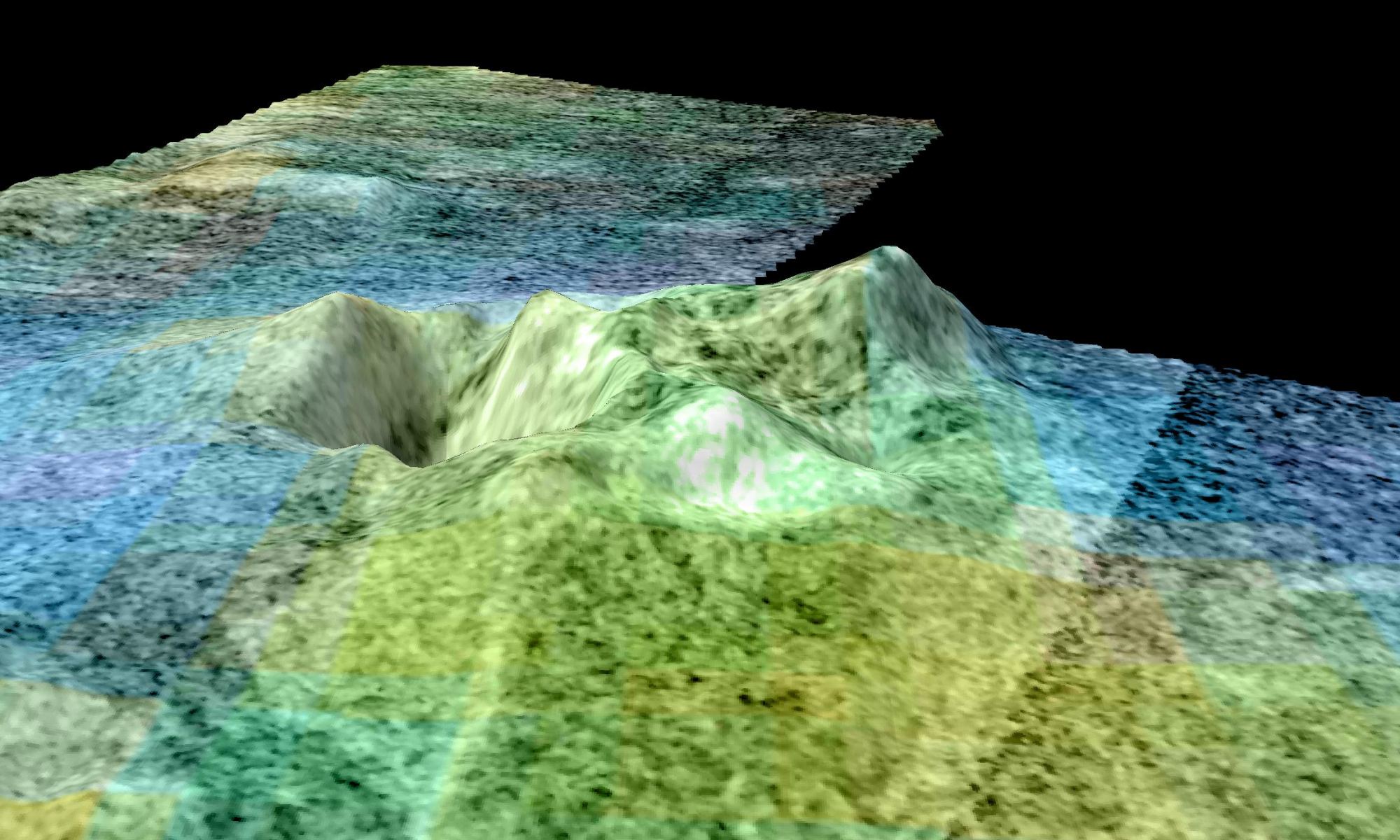Titan has become a center of increasing attention as of late. Discoveries from Cassini have only increased interest in the solar system’s second-largest moon. Liquid on its surface has already prompted one upcoming mission – the Dragonfly drone NASA plans to launch in the mid-2030s. Now a team of dozens of scientists has put their names behind a proposal to ESA for a similar mission. This one is called POSEIDON and would specialize in exploring some of TItan’s methane lakes.
Continue reading “A Mission to Explore the Methane Lakes on Titan”There are Features on Titan That Really Look Like Volcanic Craters
On Sept. 15th, 2017, NASA’s Cassini Orbiter concluded its mission by diving into Saturn’s atmosphere. Over the course of the 13 years it spent studying the Saturn system, it revealed a great deal about this gas giant and its largest moon, Titan. In the coming years, scientists are eager to send another mission to Titan to follow up on Cassini and get a better look at its surface features, methane lakes, and other curious properties.
These include the morphological features in the northern polar region that are strikingly similar to volcanic features here on Earth. According to a recent study by the Planetary Science Institute (PSI), these features could be evidence of cryovolcanism that continues to this day. These findings are the latest evidence that Titan has an interior ocean and internal heating mechanisms, which could also mean the planet harbors life in his interior.
Continue reading “There are Features on Titan That Really Look Like Volcanic Craters”Adieu Titan: So Long & Thanks For All The Hydrocarbons
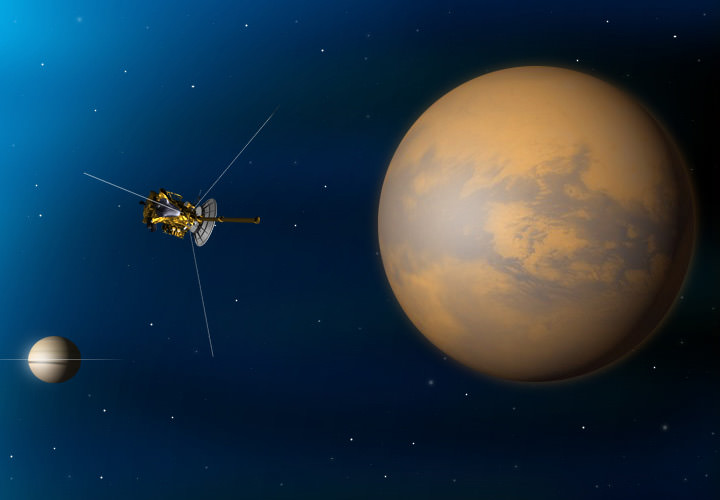
The Cassini spacecraft has done some amazing things since it arrived in the Saturn system in 2004. In addition to providing valuable information on the gas giant and its system of rings, it has also provided us with extensive data and photographs of Saturn’s many moons. Nowhere has this been more apparent than with Saturn’s largest moon, the hydrocarbon-rich satellite known as Titan.
And with just a few hours left before Cassini makes its final plunge between Saturn and its innermost ring (something that no other spacecraft has ever done), we should all take this opportunity to say goodbye to Titan. In the past few years, it has dazzled us with its methane lakes, dense atmosphere, and potential for hosting life. And it shall be sorely missed!
Cassini’s last encounter with Titan – where it passed within 979 km (608 mi) of the moon’s surface – took place on April 21st, at 11:08 p.m. PDT (April 22nd, 2:08 a.m. EDT). The probe also used this opportunity to take some radar images of the moon’s northern polar region. While this area has been photographed before, this was the first time that radar images were acquired.

Over the course of the next week, Cassini’s radar team hopes to pour over theses images, which provide a detailed look at the methane seas and lakes in the northern polar region. It is hoped that this data will allow scientists to shed more light on the depths and compositions of some of the small lakes in the area, as well as provide more information on the evolving surface feature known as “magic island“.
With this last pass complete (its 127th in total), Cassini is now beginning the final phase of its mission – known as the Grand Finale. This will consist of the spacecraft making a final set of 22 orbits around the ringed planet between April 26th and September 15th. The maneuver will allow Cassini to go where no other probe has gone before and get the closest look ever at Saturn’s outer rings.
The final pass over Titan was part of this maneuver, using the moon’s gravity to bend and reshape the probe’s orbit so that it would be able to pass through Saturn’s ring system – instead of passing just beyond the main rings. As Earl Maize, Cassini project manager at JPL, said in a NASA press release:
“With this flyby we’re committed to the Grand Finale. The spacecraft is now on a ballistic path, so that even if we were to forgo future small course adjustments using thrusters, we would still enter Saturn’s atmosphere on Sept. 15 no matter what.”
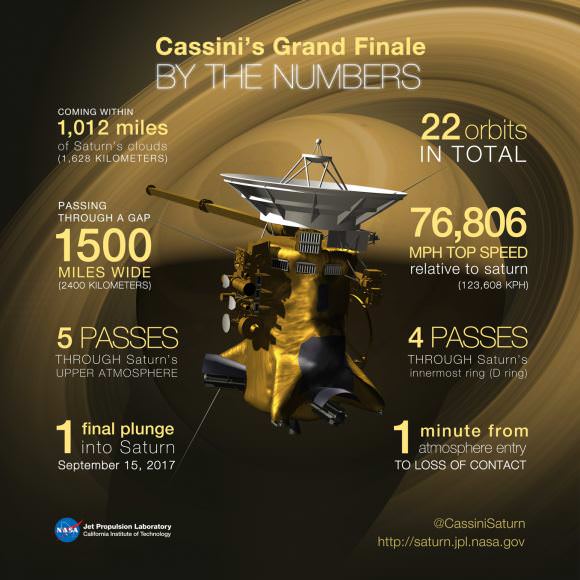
Cassini’s final pass with Titan allowed it to acquire a boost in velocity, increasing its speed by 860.5 meters per second (3098 km/h; 1,925 mph). It then reached its farthest point in its orbit around Saturn (apoapse) on April 22nd, :46 p.m. PDT (11:46 p.m. EDT). This effectively began the Grand Finale orbits, with the first dive coming on April 26th, at 02:00 a.m. PDT (05:00 a.m. EDT).
This orbit will provide Cassini with its best look to date at Saturn’s north pole, which it will be studying with both its Visible and Infrared Mapping Spectrometer (VIMS) and Composite Infrared Spectrometer (CIRS). These studies will lead to the creation of the sharpest movies to date in the near-infrared band, which will also allow the science team to study the motions of the hexagon pattern around Saturn’s north pole in more detail.
Between now and September, when the mission will end, the probe will provide information that is expected to improve our understanding of how giant planets form and evolve. Things will finally wrap on September 15th, 2017, when the probe will plunge into Saturn’s atmosphere. But even then, the probe will be sending back information until its very last seconds of operation.
Safe journeys Cassini! And so long Titan! We hope to be exploring you again someday soon, preferably with something that can float or fly around inside your dense atmosphere, or perhaps investigate your methane seas in serious depth!
In the meantime, be sure to check out this narrated, 360-degree animated video from NASA. As you can see, it simulates what a ride on the Cassini spacecraft might look like as it makes its Grand Finale:
Further Reading: NASA, Cassini – The Grand Finale
Saturn’s Moon Titan

In ancient Greek lore, the Titans were giant deities of incredible strength who ruled during the legendary Golden Age and gave birth to the Olympian gods we all know and love. Saturn‘s largest moon, known as Titan, is therefore appropriately named. In addition to being Saturn’s largest moon – and the second-largest moon in the Solar System (after Jupiter’s moon Ganymede) – it is larger by volume than even the smallest planet, Mercury.
Beyond its size, Titan is also fascinating because it is the only natural satellite known to have a dense atmosphere, a fact which has made it very difficult to study until recently. On top of all that, it is the only object other than Earth where clear evidence of stable bodies of surface liquid has been found. All of this makes Titan the focal point of a great deal of curiosity, and a prime location for future scientific missions.
Discovery and Naming:
Titan was discovered on March 25th, 1655, by the Dutch astronomer Christiaan Huygens. Huygens had been inspired by Galileo’s improvements in telescopes and his discovery of moons circling Jupiter in 1610. By 1650, he went about developing a telescope of his own with the help of his brother (Constantijn Huygens, Jr.) and observed the first moon of Saturn.
In 1655, Huygens named it Saturni Luna (Latin for “Saturn’s moon”) in a tract De Saturni Luna Observatio Nova (“A New Observation of Saturn’s Moon”). As Giovanni Domenico Cassini discoveries four more moons around Saturn between 1673 and 1686, astronomers began to refer to them as Saturn I through V (with Titan being in the fourth position as Saturn IV).

After William Herschel’s discovery of Mimas and Enceladus in 1789, which are closer to Saturn than any of the larger moons, Saturn’s moons once again had to be re-designated. Thenceforth, Titan status became fixed as Saturn VI, despite the discovery of several smaller moons that were closer to Saturn since then.
The name Titan, along with the names for all the seven major satellites of Saturn, were suggested by William Herschel’s son, John. In 1847, John Herschel published Results of Astronomical Observations Made at the Cape of Good Hope, in which he suggested that the moons be named after the mythological Titans – the brothers and sisters of Cronus, who is the Greek equivalent to Saturn.
In 1907, Spanish astronomer Josep Comas i Solà observed limb darkening of Titan. This effect, where the center part of a planet or star appears brighter than the edge (or limb), was the first indication that Titan had an atmosphere. In 1944, Gerard P. Kuiper used a spectroscopic technique to determine that Titan had an atmosphere composed of methane.
Size. Mass and Orbit:
With a mean radius of 2576 ± 2 km and a mass of 1.345 × 1023 kg, Titan is 0.404 the size of Earth (or 1.480 Moons) and 0.0225 times as massive (1.829 Moons). Its orbit has a minor eccentricity of 0.0288, and its orbital plane is inclined 0.348 degrees relative to Saturn’s equator. It’s average distance from Saturn (semi-major axis) is 1,221,870 km – ranging from 1,186,680 km at periapsis (closest) to 1,257,060 km at apoapsis (farthest).
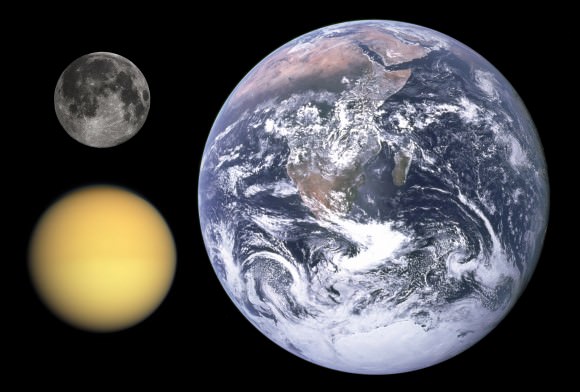
Titan takes 15 days and 22 hours to complete a single orbit of Saturn. Like the Moon and many satellites that orbit the other gas giants, its rotational period is identical to its orbital period. Thus, Titan is tidally-locked and in a synchronous rotation with Saturn, which means one face is permanently pointed towards the planet.
Composition and Surface Features:
Though similar in composition to Dione and Enceladus, Titan is denser due to gravitational compression. In terms of diameter and mass (and hence density) Titan is more similar to the Jovian moons of Ganymede and Callisto. Based on its bulk density of 1.88 g/cm3, Titan’s composition is believed to consist half of water ice and half of rocky material.
It’s internal makeup is likely differentiated into several layers, with a 3,400-kilometre (2,100 mi) rocky center surrounded by layers composed of different forms of crystalized ice. Based on evidence provided by the Cassini-Huygens mission in 2005, it is believed that Titan may also have a subsurface ocean which exists between the crust and several deeper layers of high-pressure ice.
This subsurface ocean is believed to be made up of water and ammonia, which allows the water to remain in a liquid state even at temperatures as low as 176 K (-97 °C). Evidence of a systematic shift of the moon’s surface features (which took place between October 2005 and May 2007) suggests that the crust is decoupled from the interior – possibly by a liquid layer in between – as well as the way the gravity field varies as Titan orbits Saturn.
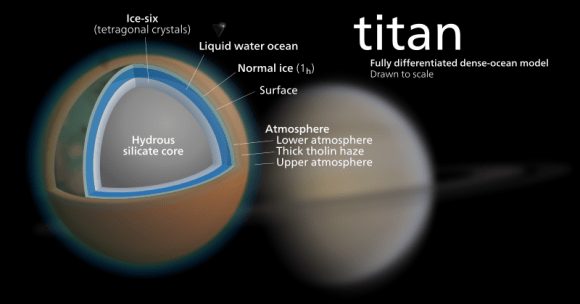
The surface of Titan is relatively young – between 100 million and 1 billion years old – despite having been formed during the early Solar System. In addition, it appears to be relatively smooth, with impact craters having been filled in. Height variation is also low, ranging by little more than 150 meters, but with the occasional mountain reaching between 500 meters and 1 km in height.
This is believed to due to geological processes which have reshaped Titan’s surface over time. For example, a range measuring 150 km (93 mi) long, 30 km (19 mi) wide, and 1.5 km (0.93 mi) tall has been potted in the southern hemisphere, composed of icy material and covered in methane snow. The movement of tectonic plates, perhaps influenced by a nearby impact basin, could have opened a gap through which the mountain’s material upwelled.
Then there is Sotra Patera, a chain of mountains that is 1000 to 1500 m (0.62 and 0.93 mi) in height, has some peaks topped by craters, and what appears to be frozen lava flows at its base. If volcanism on Titan really exists, the hypothesis is that it is driven by energy released from the decay of radioactive elements within the mantle, tidal flexing caused by Saturn’s influence, or possibly the interaction of Titan’s subsurface ice layers.
An alternate theory is that Titan is a geologically dead world and that the surface is shaped by a combination of impact cratering, flowing-liquid and wind-driven erosion, mass wasting and other externally-motivated processes. According to this hypothesis, methane is not emitted by volcanoes but slowly diffuses out of Titan’s cold and stiff interior.
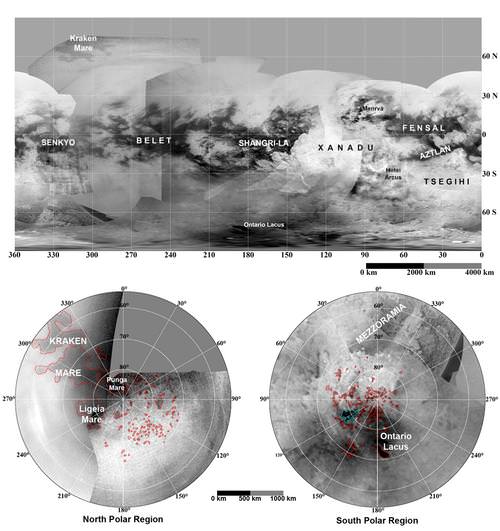
The few impact craters discovered on Titan’s surface include a 440 km (270 mi) wide two-ring impact basin named Menrva, which is identifiable from its bright-dark concentric pattern. A smaller, 60 km (37 mi) wide, flat-floored crater named Sinlap and a 30 km (19 mi) crater with a central peak and dark floor named Ksa have also been observed.
Radar and orbital imaging has also revealed a number of “crateriforms” on the surface, circular features that may be impact related. These include a 90 km (56 mi) wide ring of bright, rough material known as Guabonito, which is thought to be an impact crater filled in by dark, windblown sediment. Several other similar features have been observed in the dark Shangri-la and Aaru regions.
The presence of cryovolcanism has also been theorized based on the fact that there is apparently not enough liquid methane on Titan’s surface (see below) to account for the atmospheric methane. However, to date, the only indications of cryovolcanism are particularly bright and dark features on the surface and 200 m (660 ft) structures resembling lava flows that were spotted in the region called Hotei Arcus.
Titan’s surface is also permeated by streaky features (aka. “sand dunes“), some of which are hundreds of kilometers in length and several meters high. These appear to be caused by powerful, alternating winds that are caused by the interaction of the Sun and Titan’s dense atmosphere. Titan’s surface is also marked by broad regions of bright and dark terrain.
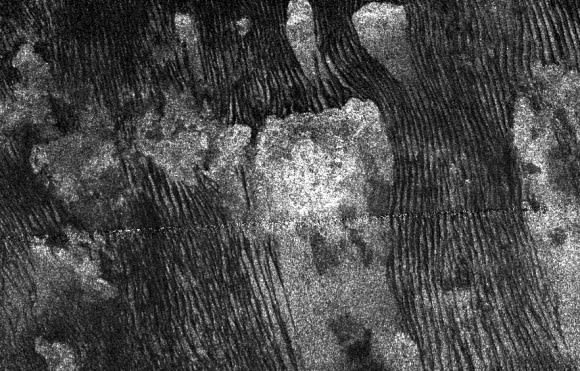
These include Xanadu, a large, reflective equatorial area that was first identified by the Hubble Space Telescope in 1994 and later by the Cassini spacecraft. This region (which is about the same size as Australia) is very diverse, being filled with hills, valleys, chasms and crisscrossed in places by dark lineaments – sinuous topographical features resembling ridges or crevices.
These could be an indication of tectonic activity, which would mean that Xanadu is geologically young. Alternatively, the lineaments may be liquid-formed channels, suggesting old terrain that has been cut through by stream systems. There are dark areas of similar size elsewhere on Titan, which have been revealed to be the patches of water ice and organic compounds that darkened due to exposure to UV radiation.
Methane Lakes:
Titan is also home to its famous “hydrocarbon seas”, lakes of liquid methane and other hydrocarbon compounds. Many of these have been spotted near the polar regions, such as Ontario Lacus. This confirmed methane lake near the south pole has a surface area of 15,000 km² (making it 20% smaller than its namesake, Lake Ontario) and a maximum depth of 7 meters (23 feet).
But the largest body of liquid is Kraken Mare, a methane lake near the north pole. With a surface area of about 400,000 km², it is larger than the Caspian Sea and is estimated to be 160 meters deep. Shallow capillary waves (aka. ripple waves) that are 1.5 centimeters high and moving at speeds of 0.7 meters per second have also been detected.
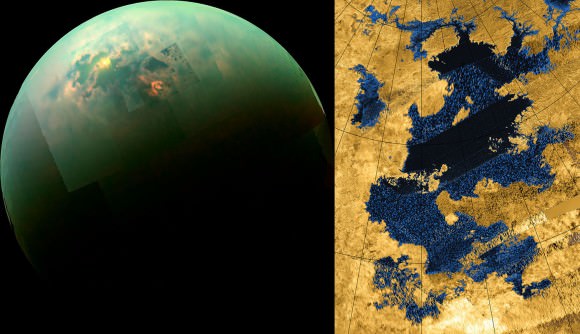
Then there is Ligeia Mare, the second largest known body of liquid on Titan, which is connected to Kraken Mare and also located near the north pole. With a surface area of about 126,000 km² and a shoreline that is over 2000 km (1240 mi) in length, it is larger than Lake Superior. Much like Kraken Mare, it takes its name from Greek mythology; in this case, after one of the sirens.
It was here that NASA first noticed a bright object measuring 260 km² (100 square miles), which they named “Magic Island”. This object was first spotted in July 2013, then disappeared later, only to reappear again (slightly changed) in August 2014 . It is believed to be inked to Titan’s changing seasons, and suggestions as to what it might be range from surface waves and rising bubbles to floating solids suspended beneath the surface.
Although most of the lakes are concentrated near the poles (where low levels of sunlight prevent evaporation), a number of hydrocarbon lakes have also been discovered in the equatorial desert regions. This includes one near the Huygens landing site in the Shangri-la region, which is about half the size of Utah’s Great Salt Lake. Like desert oases on Earth, it is speculated that these equatorial lakes are fed by underground aquifers.
Overall, the Cassini radar observations have shown that lakes cover only a few percent of the surface, making Titan much drier than Earth. However, the probe also provided strong indications that considerable liquid water exists 100 km below the surface. Further analysis of the data suggests that this ocean may be as salty as the Dead Sea.
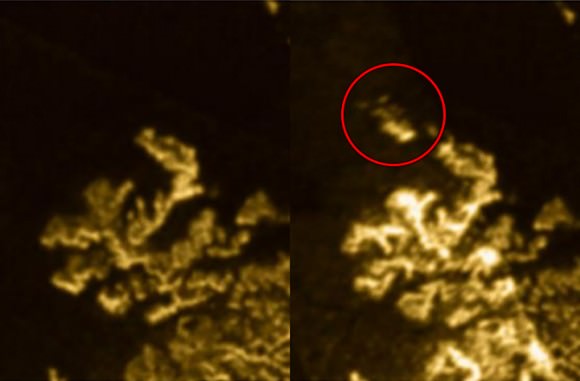
Other studies suggest methane rainfall (see below) on Titan may interact with icy materials underground to produce ethane and propane that may eventually feed into rivers and lakes.
Atmosphere:
Titan is the only moon in the Solar System with a significant atmosphere, and the only body other than Earth who’s atmosphere is nitrogen-rich. Recent observations have shown that Titan’s atmosphere is denser than Earth’s, with a surface pressure of about 1.469 KPa – 1.45 times that of Earths. It is also about 1.19 times as massive as Earth’s atmosphere overall, or about 7.3 times more massive on a per-surface-area basis.
The atmosphere is made up of opaque haze layers and other sources that block most visible light from the Sun and obscure its surface features (similar to Venus). Titan’s lower gravity also means that its atmosphere is far more extended than Earth’s. In the stratosphere, the atmospheric composition is 98.4% nitrogen with the remaining 1.6% composed mostly of methane (1.4%) and hydrogen (0.1–0.2%).
There are trace amounts of other hydrocarbons, such as ethane, diacetylene, methylacetylene, acetylene and propane; as well as other gases such as cyanoacetylene, hydrogen cyanide, carbon dioxide, carbon monoxide, cyanogen, argon and helium. The hydrocarbons are thought to form in Titan’s upper atmosphere in reactions resulting from the breakup of methane by the Sun’s ultraviolet light, producing a thick orange smog.
Energy from the Sun should have converted all traces of methane in Titan’s atmosphere into more complex hydrocarbons within 50 million years—a short time compared to the age of the Solar System. This suggests that methane must be replenished by a reservoir on or within Titan itself. The ultimate origin of the methane in its atmosphere may be its interior, released via eruptions from cryovolcanoes.
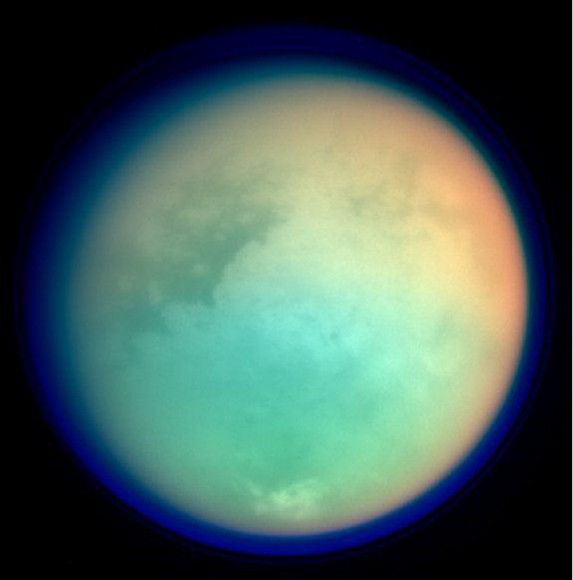
Titan’s surface temperature is about 94 K (-179.2 °C), which is due to the fact that Titan receives about 1% as much sunlight as Earth. At this temperature, water ice has an extremely low vapor pressure, so the little water vapor present appears limited to the stratosphere. The moon would be much colder, were it not for the fact that the atmospheric methane creates a greenhouse effect on Titan’s surface.
Conversely, haze in Titan’s atmosphere contributes to an anti-greenhouse effect by reflecting sunlight back into space, cancelling a portion of the greenhouse effect and making its surface significantly colder than its upper atmosphere. In addition, Titan’s atmosphere periodically rains liquid methane and other organic compounds onto its surface.
Based on studies simulating the atmosphere of Titan, NASA scientists have speculated that complex organic molecules could arise on Titan (see below). In addition, propene – aka. propylene, a class of hydrocarbon – has also been detected in Titan’s atmosphere. This is the first time propene has been found on any moon or planet other than Earth, and is thought to be formed from recombined radicals created by the UV photolysis of methane.
Habitability:
Titan is thought to be a prebiotic environment rich in complex organic chemistry with a possible subsurface liquid ocean serving as a biotic environment. Ongoing research of Titan’s atmosphere has led many scientists to theorize that conditions there are similar to what existed on a primordial Earth, with the important exception of a lack of water vapor.
Numerous experiments have shown that an atmosphere similar to that of Titan, with the addition of UV radiation, could give rise to complex molecules and polymer substances like tholins. In addition, independent research conducted by the University of Arizona reported that when energy was applied to a combination of gases like those found in Titan’s atmosphere, many organic compounds were produced. These includes the five nucleotide bases – the building blocks of DNA and RNA – as well as amino acids, which are the building blocks of protein.
Multiple laboratory simulations have been conducted that have led to the suggestion that enough organic material exists on Titan to start a chemical evolution process analogous to what is thought to have started life here on Earth. While this theory assumes the presence of water that would remain in a liquid state for longer periods that have been observed, organic life could theoretically survive in Titan’s hypothetical subsurface ocean.
Much like on Europa and other moons, this life would likely take the form of extremophiles – organisms that thrive in extreme environments. Heat transfer between the interior and upper layers would be critical in sustaining any subsurface oceanic life, most likely through hydrothermal vents located at the ocean-core boundary. That the atmospheric methane and nitrogen might be of biological origin has also been examined.
It has also been suggested that life could exist in Titan’s lakes of liquid methane, just as organisms on Earth live in water. Such organisms would inhale dihydrogen (H²) in place of oxygen gas (O²), metabolize it with acetylene instead of glucose, and then exhale methane instead of carbon dioxide. Although all living things on Earth use liquid water as a solvent, it is speculated that life on Titan could actually live in liquid hydrocarbons.
Several experiments and models have been constructed to test this hypothesis. For instance, atmospheric models have shown that molecular hydrogen is in greater abundance in the upper atmosphere and disappears near the surface – which is consistent with the possibility of methanogenic life-forms. Another study has shown that there are low levels of acetylene on Titan’s surface, which is also in line with the hypothesis of organisms consuming hydrocarbons.
In 2015, a team of chemical engineers at Cornell University went as far as to construct a hypothetical cell membrane that was capable of functioning in liquid methane under conditions similar to that on Titan. Composed of small molecules containing carbon, hydrogen, and nitrogen, this cell was said to have the same stability and flexibility as cell membranes on Earth. This hypothetical cell membrane was termed an “azotosome” (a combination of “azote”, French for nitrogen, and “liposome”).
However, NASA has gone on record as stating that these theories remain entirely hypothetical. Furthermore, it has been emphasized that other theories as to why hydrogen and acetylene levels are lower nearer to the surface are more plausible. These include a as-of-yet unidentified physical or chemical processes – such as a surface catalyst accepting hydrocarbons or hydrogen – or the existence of flaws in the current models of material flow.
Also, life on Titan would face tremendous obstacles compared to life on Earth – thus making any analogy to Earth problematic. For one, Titan is too far from the Sun, and its atmosphere lacks carbon monoxide (CO), which results in it not retaining enough heat or energy to trigger biological processes. Also, water only exists on Titan’s surface in solid form.
So while the prebiotic conditions that are associated with organic chemistry exist on Titan, life itself may not. However, the existence of these conditions remains a subject of fascination among scientists. And since its atmosphere is thought to be analogous to Earth’s in the distant past, researching Titan could help advance our understanding of the early history of the terrestrial biosphere.
Exploration:
Titan cannot be spotted without the help of instrumentation, and is often difficult for amateur astronomers because of interference from Saturn’s brilliant globe and ring system. And even after the development of high-powered telescopes, Titan’s dense, hazy, atmosphere made observations of the surface very difficult. Hence, observations of both Titan and its surface features prior to the space age were limited.
The first probe to visit the Saturnian system was Pioneer 11 in 1979, which took images of Titan and Saturn together and revealed that Titan was probably too cold to support life. Titan was examined in 1980 and 1981 by both the Voyager 1 and 2 space probes, respectively. While Voyager 2 managed to take snapshots of Titan on its way to Uranus and Neptune, only Voyager 1 managed to conduct a flyby and take pictures and readings.
This included readings on Titan’s density, composition, and temperature of the atmosphere, and obtain a precise measurement of Titan’s mass. Atmospheric haze prevented direct imaging of the surface; though in 2004, intensive digital processing of images taken through Voyager 1‘s orange filter did reveal hints of the light and dark features now known as Xanadu and Shangri-la.
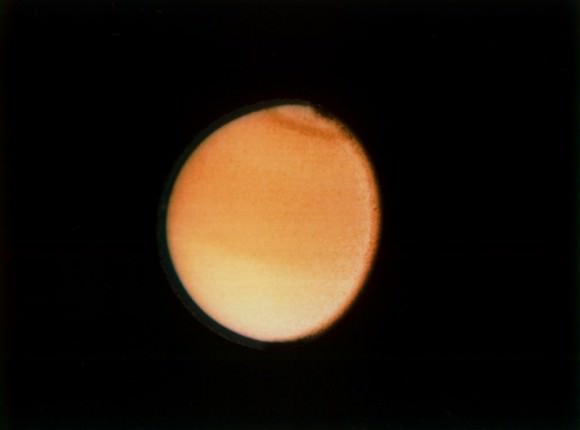
Even so, much of the mystery surrounding Titan would not begin to be dispelled until the Cassini-Huygens mission – a joint project between NASA and the European Space Agency (ESA) named in honor of the astronomers who made the greatest discoveries involving Saturn’s moons. The spacecraft reached Saturn on July 1st, 2004, and began the process of mapping Titan’s surface by radar.
The Cassini probe flew by Titan on October 26th, 2004, and took the highest-resolution images ever of Titan’s surface, discerning patches of light and dark that were otherwise invisible to the human eye. Over the course of many close flybys of Titan, Cassini managed to detect abundant sources of liquid on the surface in the north polar region, in the form of many lakes and seas.
The Huygens probe landed on Titan on January 14th, 2005, making Titan the most distant body from Earth to have a space probe land on its surface. During the course of its investigations, it would discover that many of the surface features appear to have been formed by fluids at some point in the past.
After landing just off the easternmost tip of the bright region now called Adiri, the probe photographed pale hills with dark “rivers” running down to a dark plain. The current theory is that these hills (aka. “highlands”) are composed mainly of water ice, and that dark organic compounds – created in the upper atmosphere – may come down from Titan’s atmosphere with methane rain and become deposited on the plains over time.
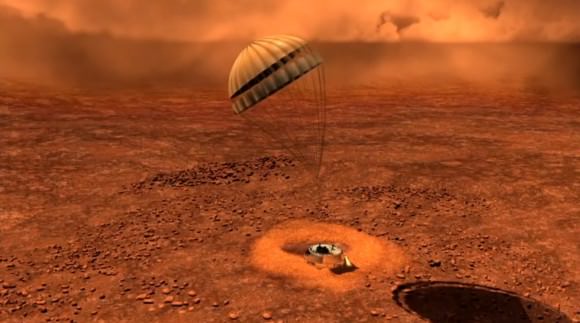
Huygens also obtained photographs of a dark plain covered in small rocks and pebbles (composed of water ice) that showed evidence of erosion and/or fluvial activity. The surface is darker than originally expected, consisting of a mixture of water and hydrocarbon ice. The “soil” visible in the images is interpreted to be precipitation from the hydrocarbon haze above.
Several proposals for returning a robotic space probe to Titan have been made in recent years. These include the Titan Saturn System Mission (TSSM) – a joint NASA/ESA proposal for the exploration of Saturn’s moons – that envisions a hot-air balloon floating in Titan’s atmosphere and conducting research for a period of six months.
In 2009, it was announced that the TSSM lost out to a competing concept known the Europa Jupiter System Mission (EJSM) – a joint NASA/ESA mission that will consist of sending two probes to Europa and Ganymede to study their potential habitability.
There was also a proposal known as Titan Mare Explorer (TiME), a concept under consideration by NASA in conjunction with Lockheed Martin. This mission would involve a low-cost lander splashing down in a lake in Titan’s northern hemisphere and floating on the surface of the lake for 3 to 6 months. However, NASA announced in 2012 that it favored the lower-cost InSight Mars lander instead, which is scheduled to be sent to Mars in 2016.
Another mission to Titan was proposed in early 2012 by Jason Barnes, a scientist at the University of Idaho. Known as the Aerial Vehicle for In-situ and Airborne Titan Reconnaissance (AVIATR), this unmanned plane (or drone) would fly through Titan’s atmosphere and take high-definition images of the surface. NASA did not approve the requested $715 million at the time and the future of the project is uncertain.
Another lake lander project known as the Titan Lake In-situ Sampling Propelled Explorer (TALISE) was proposed in late 2012 by the Spanish-based private engineering firm SENER and the Centro de Astrobiología in Madrid. The major difference between this and the TiME probe is that the TALISE concept includes its own propulsion system, and would therefore not be limited to simply drifting on the lake when it splashes down.
In response to NASA’s 2010 Discovery Announcement, the concept known as Journey to Enceladus and Titan (JET) was proposed. Developed by Caltech and JPL, this mission would consist of a low-cost astrobiology orbiter that would be sent to the Saturnian system to asses the habitability potential of Enceladus and Titan.
In 2015, NASA’s Innovative Advanced Concepts (NIAC) awarded a Phase II grant to a proposed robotic submarine in order to further investigate and develop the concept. This submarine explorer, should it be deployed to Titan, will explore the depths of Kraken Mare to investigate its makeup and potential for supporting life.
Colonization:
The colonization of the Saturn system presents numerous advantages compared to other gas giants in the Solar System. According to Dr. Robert Zubrin – an American aerospace engineer, author, and an advocate for the exploration Mars – these include its relative proximity to Earth, its low radiation, and its excellent system of moons. Zubrin has also stated that Titan is the most important of these moons when it comes to building a base to develop the system’s resources.
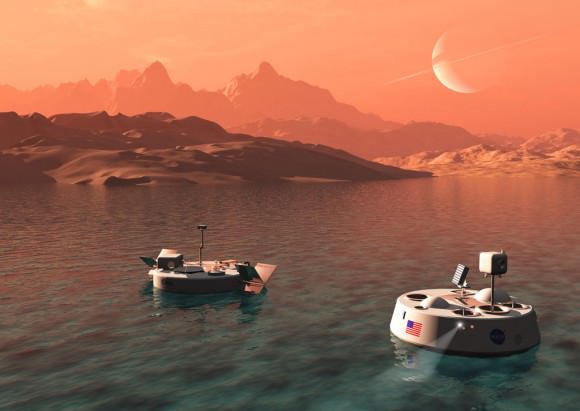
For starters, Titan possess an abundance of all the elements necessary to support life, such as atmospheric nitrogen and methane, liquid methane, and liquid water and ammonia. Water could easily be used to generate breathable oxygen, and nitrogen is ideal as a buffer gas to create a pressurized, breathable atmosphere. In addition, nitrogen, methane and ammonia could all be used to produce fertilizer for growing food.
Additionally, Titan has an atmospheric pressure one and a half times that of Earth, which means that the interior air pressure of landing craft and habitats could be set equal or close to the exterior pressure. This would significantly reduce the difficulty and complexity of structural engineering for landing craft and habitats compared with low or zero pressure environments such as on the Moon, Mars, or the Asteroid Belt.
The thick atmosphere also makes radiation a non-issue, unlike with other planets or Jupiter’s moons. And while Titan’s atmosphere does contain flammable compounds, these only present a danger if they are mixed with sufficient enough oxygen – otherwise, combustion cannot be achieved or sustained. Finally, the very high ratio of atmospheric density to surface gravity also greatly reduces the wingspan needed for aircraft to maintain lift.
Beyond this, Titan presents many challenges for human colonization. For starters, the moon has a surface gravity of 0.138 g, which is slightly less than that of the Moon. Managing the long-term effects of this presents a challenge, and what those effects would be (especially for children born on Titan) are not currently known. However, they would likely include loss of bone density, muscle deterioration, and a weakened immune system.
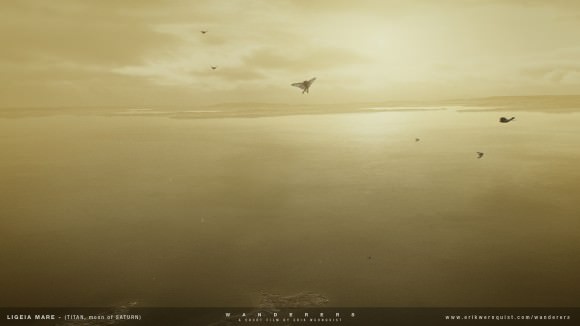
The temperature on Titan is also considerably lower than on Earth, with an average temperature of 94 K (-179 °C, or -290.2 °F). Combined with the increased atmospheric pressure, temperatures vary very little over time and from one local to the next. Unlike in a vacuum, the high atmospheric density makes thermoinsulation a significant engineering problem. Nevetherless, compared to other cases for colonization, the problems associated with creating a human presence on Titan are relatively surmountable.
Titan is a moon that is shrouded in mystery, both literally and metaphorically. Until very recently, we were unable to discern what secrets it held because its atmosphere was simply too thick to see beneath. However, in recent years, we have managed to pull back that shroud and get a better look at the moon’s surface. But in many ways, doing this has only confounded the sense of mystery surrounding this world.
Perhaps someday we will send astronauts to Titan and find life forms there that completely alter our conception of what life is and where it can thrive. Perhaps we will find only extremophiles, life forms that live in the deepest parts of its interior ocean huddled around hydorthermal vents, since these spots are the only place on Titan where lifeforms can exist.
Perhaps we will even colonize Titan someday, and use it as a base for further exploration of the Solar System and resource extraction. Then, we may come to know the pleasures of looking up at a ringed planet in the sky while sailing on a methane lake, the hazy light of the Sun trickling down onto the cold, hydrocarbon seas. One can only hope… and dream!
We have many interesting articles about Titan here at Universe Today. Here are some on Titan’s atmosphere, it’s mysterious sand dunes, and how we might explore it with a robotic sailboat.
For more information on Titan’s methane lakes, check out this article on Titan’s north pole, and this one about Kraken Mare.
Here’s NASA’s Cassini mission to Saturn and Titan, and here’s the ESA’s version.
We have recorded two episodes of Astronomy Cast just about Saturn. The first is Episode 59: Saturn, and the second is Episode 61: Saturn’s Moons.
Storms And Lakes On Titan Revealed By Computer Modeling
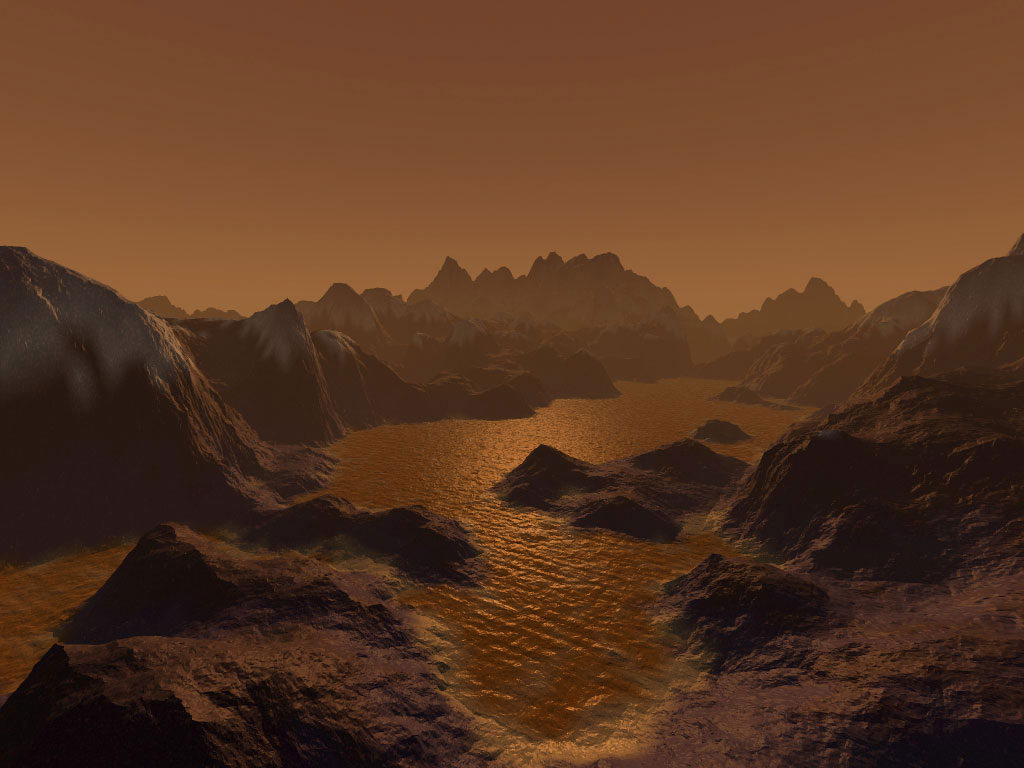
[/caption]
Thanks to the Cassini mission and the Huygens probe, we’ve glimpsed a wet world when science took a look at Saturn’s moon, Titan. Its atmosphere is rich in methane and its average temperature is about -300 degrees Fahrenheit (about 90 kelvins). Although the chemical composition is different than ours, Titan still has similar features such as clouds, fog, rain and even lakes. However, the origin of these features haven’t really been well explained until now.
Researchers at the California Institute of Technology (Caltech) have been hard at work creating a computer program based on observations made by Cassini imaging and radar that could help explain Titan’s weather patterns and liquid surface deposits. One major oddity was discovered in 2009 when Oded Aharonson, Caltech professor of planetary science, and his team confirmed Titan’s lakes appeared to be gathered around its poles – more predominately in the northern hemisphere than compared to the south – yet that’s not the only curiosity. The areas around the equator were suspected to be dry, but the Huygens probe revealed areas of run-off and four years later researchers observed a storm system delivering moisture. Need more? Then check out the clouds observed by ground-based telescopes… They gather around southern middle and high latitudes during Titan’s southern hemisphere summer season.
“We can watch for years and see almost nothing happen. This is bad news for people trying to understand Titan’s meteorological cycle, as not only do things happen infrequently, but we tend to miss them when they DO happen, because nobody wants to waste time on big telescopes—which you need to study where the clouds are and what is happening to them—looking at things that don’t happen,” explains Mike Brown of the California Institute of Technology (Caltech).
Sure. The researchers have worked hard at creating models that could explain these exotic weather features, but such explanations involve way out theories, such as cryogenic volcanoes that blast out methane vapor to cause clouds. However, the latest computer renderings are much more basic – the principles of atmospheric circulation. “We have a unified explanation for many of the observed features,” says Tapio Schneider, the Frank J. Gilloon Professor of Environmental Science and Engineering. “It doesn’t require cryovolcanoes or anything esoteric.” Schneider, along with Caltech graduate student Sonja Graves, former Caltech graduate student Emily Schaller (PhD ’08), and Mike Brown, the Richard and Barbara Rosenberg Professor and professor of planetary astronomy, have published their findings in the January 5 issue of the journal Nature.
Why is this data set different than its predecessors? According the Schneider, these new simulations were able to reproduce cloud patterns which match factual observations – right down to the distribution of lakes. “Methane tends to collect in lakes around the poles because the sunlight there is weaker on average,” he explains. “Energy from the sun normally evaporates liquid methane on the surface, but since there’s generally less sunlight at the poles, it’s easier for liquid methane there to accumulate into lakes.” Because Titan has an elongated orbit, it’s a bit further away during the northern hemisphere summer allowing for a longer rainy season and thus a stronger accumulation of lakes.
So what about storms? Near the equator, Titan isn’t very exciting – or is it? Originally it was theorized the area was almost desert-like. That’s why when the Huygens probe discovered evidence of run-off, it became apparent that existing models could be wrong. Imagine the surprise when Schaller, Brown, Schneider, and then-postdoctoral scholar Henry Roe discovered storms in this supposedly arid region in 2009! No one could figure it out and the programs did little more than predict a drizzle. With the new model, heavy rains became a possibility. “It rains very rarely at low latitudes,” Schneider says. “But when it rains, it pours.”
So what else makes the new Titan weather computer model even more unique? This time it runs for 135 Titan years and links the methane lakes – and how methane is distributed – to its atmosphere. According to the research, this matches current Titan weather observations and will help to predict what could be seen in coming years. Making testable predictions is “a rare and beautiful opportunity in the planetary sciences,” Schneider says. “In a few years, we’ll know how right or wrong they are.”
“This is just the beginning,” he adds. “We now have a tool to do new science with, and there’s a lot we can do and will do.”
Original Story Source: California Institute of Technology News Release. For Further Reading: Caltech Scientists Discover Storms in the Tropics of Titan.


